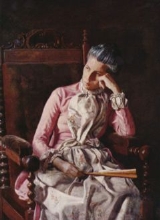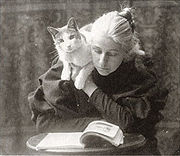
Miss Amelia Van Buren
Encyclopedia
Miss Amelia Van Buren or Portrait of Amelia C. Van Buren is a ca. 1891 painting by the American artist Thomas Eakins
(1844-1916), now in the The Phillips Collection. It depicts Amelia Van Buren
(c. 1856-1942), an artist who studied with Eakins, and was called "one of his most gifted pupils." The painting is considered one of Eakins's finest works.
in 1884 and 1885. In 1886 Eakins described her as
Eakins's helpfulness included unusual methods: he once disrobed privately for Van Buren in order to demonstrate an anatomical point, an action that he characterized as purely professional. Nevertheless, the story was one of numerous controversial incidents used by Eakins's political adversaries to prompt his dismissal from the Pennsylvania Academy.
After she had ceased studying with Eakins, Van Buren frequently stayed as a guest in his Mount Vernon Street home, and likely posed for the painting during one of her visits to Philadelphia. Although the painting is dated c. 1891, it is also possible that the portrait could have been painted during a long stay with Eakins and his wife from December 6, 1888 to August 12, 1889. Another friend and student of Eakins's, Charles Bregler, later wrote "I recall with pleasure looking on for several hours one afternoon while he (Eakins) was painting in this room that beautiful portrait of Miss Van Buren....No conversation took place, his attention being entirely concentrated on the painting."
Van Buren eventually left painting to devote herself to photography. There exist several photographs of her that have been attributed to Eakins or his circle. She established a Boston marriage
with fellow Eakins student Eva Watson.
-revival chair, a prop that Eakins often used for his studio portraits. It is selectively detailed, so as to support without distracting from Van Buren's figure. Van Buren's dress contains complex passages, composed in part of broad, brilliant pink forms, and of creased light-colored fabric with floral patterns.
Her body twists "like an overused spring", culminating in the focal point of her head, its anatomical structure exactingly rendered, the broad forehead suggesting the sitter's intellectual presence. She exhibits what one reviewer had already referred to as "an Eakinsish expression", characteristic of his ability to portray "mere thinking without the aid of gesture or attitude." In a letter from his youth, Eakins explained his interest in the:
Van Buren was often unwell, and was diagnosed as having neurasthenia
; in 1886 she wrote to Eakins's wife Susan: "I have at last discovered that the trouble with me is in my head it is exhausted by worry or something or other..." The portrait seems to indicate as much. Touching on the picture's melancholy, John Updike
referred to the painting when he wrote "Discomfort and a grieving inwardness distinguish the best of his (Eakins's) many portraits." The sense of weariness has been interpreted also as a projection of Eakins's personality, especially in the wake of his professional difficulties. As a psychological study, it has been noted that such a profound rendering of a former student is unusual, and that the painting may be seen as a sort of self-portrait.
 Miss Amelia Van Buren was only the second portrait of a woman from outside his family that Eakins showed publicly; at neither the Philadelphia prelude to the World's Columbian Exposition
Miss Amelia Van Buren was only the second portrait of a woman from outside his family that Eakins showed publicly; at neither the Philadelphia prelude to the World's Columbian Exposition
nor subsequently in Chicago did it receive much mention in the press. More recent praise has been unqualified. William Innes Homer
has called it "superb', and written that "Such a painting can hold its own against the best work of any of Eakins's contemporaries, no matter what their country of origin." For John Canaday
, it was "the finest of all American portraits."
Thomas Eakins
Thomas Cowperthwait Eakins was an American realist painter, photographer, sculptor, and fine arts educator...
(1844-1916), now in the The Phillips Collection. It depicts Amelia Van Buren
Amelia Van Buren
Amelia C. Van Buren was an American photographer who was best known for being the subject of Thomas Eakins's c. 1891 painting Miss Amelia Van Buren.-Pennsylvania Academy of the Fine Arts:...
(c. 1856-1942), an artist who studied with Eakins, and was called "one of his most gifted pupils." The painting is considered one of Eakins's finest works.
Background
Van Buren studied with Eakins at the Pennsylvania Academy of the Fine ArtsPennsylvania Academy of the Fine Arts
The Pennsylvania Academy of the Fine Arts is a museum and art school in Philadelphia, Pennsylvania. It was founded in 1805 and is the oldest art museum and school in the United States. The academy's museum is internationally known for its collections of 19th and 20th century American paintings,...
in 1884 and 1885. In 1886 Eakins described her as
"a lady of perhaps thirty years or more, and from Detroit[.] She came to the Academy some years ago to study figure painting by which art she hoped to support herself, her parents I believe being dead. I early recognized her as a very capable person. She had a temperament sensitive to color and form, was grave, earnest, thoughtful, and industrious. She soon surpassed her fellows, and I marked her as one I ought to help in every way...."
Eakins's helpfulness included unusual methods: he once disrobed privately for Van Buren in order to demonstrate an anatomical point, an action that he characterized as purely professional. Nevertheless, the story was one of numerous controversial incidents used by Eakins's political adversaries to prompt his dismissal from the Pennsylvania Academy.
After she had ceased studying with Eakins, Van Buren frequently stayed as a guest in his Mount Vernon Street home, and likely posed for the painting during one of her visits to Philadelphia. Although the painting is dated c. 1891, it is also possible that the portrait could have been painted during a long stay with Eakins and his wife from December 6, 1888 to August 12, 1889. Another friend and student of Eakins's, Charles Bregler, later wrote "I recall with pleasure looking on for several hours one afternoon while he (Eakins) was painting in this room that beautiful portrait of Miss Van Buren....No conversation took place, his attention being entirely concentrated on the painting."
Van Buren eventually left painting to devote herself to photography. There exist several photographs of her that have been attributed to Eakins or his circle. She established a Boston marriage
Boston marriage
Boston marriage as a term is said to have been in use in New England in the decades spanning the late 19th and early 20th centuries to describe two women living together, independent of financial support from a man. The term was little known until the debut in 2000 of the David Mamet play of the...
with fellow Eakins student Eva Watson.
Composition
Van Buren's seated figure creates a pyramidal composition, activated by the movement of her head, arms, and torso. Her body is illuminated and given sculptural form by a strong shaft of light coming from the left. Her face is thin and serious, her graying hair pulled back, as she supports her head with her left hand, her right hand counterpoised in her lap, holding a fan. For Eakins's biographer John Wilmerding, the contrast between the arms is noteworthy: one arm is solid and "architectural...suggestive of an unspoken potential for great vitality", and "the anchor of the portrait" that belies the otherwise reflective countenance; the other hand is shadowed and limp. She sits in a JacobeanJacobean era
The Jacobean era refers to the period in English and Scottish history that coincides with the reign of King James VI of Scotland, who also inherited the crown of England in 1603 as James I...
-revival chair, a prop that Eakins often used for his studio portraits. It is selectively detailed, so as to support without distracting from Van Buren's figure. Van Buren's dress contains complex passages, composed in part of broad, brilliant pink forms, and of creased light-colored fabric with floral patterns.
Her body twists "like an overused spring", culminating in the focal point of her head, its anatomical structure exactingly rendered, the broad forehead suggesting the sitter's intellectual presence. She exhibits what one reviewer had already referred to as "an Eakinsish expression", characteristic of his ability to portray "mere thinking without the aid of gesture or attitude." In a letter from his youth, Eakins explained his interest in the:
"higher class[,] the thinking people and feeling ones who always want to see everything [and] to know more".
Van Buren was often unwell, and was diagnosed as having neurasthenia
Neurasthenia
Neurasthenia is a psycho-pathological term first used by George Miller Beard in 1869 to denote a condition with symptoms of fatigue, anxiety, headache, neuralgia and depressed mood...
; in 1886 she wrote to Eakins's wife Susan: "I have at last discovered that the trouble with me is in my head it is exhausted by worry or something or other..." The portrait seems to indicate as much. Touching on the picture's melancholy, John Updike
John Updike
John Hoyer Updike was an American novelist, poet, short story writer, art critic, and literary critic....
referred to the painting when he wrote "Discomfort and a grieving inwardness distinguish the best of his (Eakins's) many portraits." The sense of weariness has been interpreted also as a projection of Eakins's personality, especially in the wake of his professional difficulties. As a psychological study, it has been noted that such a profound rendering of a former student is unusual, and that the painting may be seen as a sort of self-portrait.
Reception

World's Columbian Exposition
The World's Columbian Exposition was a World's Fair held in Chicago in 1893 to celebrate the 400th anniversary of Christopher Columbus's arrival in the New World in 1492. Chicago bested New York City; Washington, D.C.; and St...
nor subsequently in Chicago did it receive much mention in the press. More recent praise has been unqualified. William Innes Homer
William Innes Homer
William Innes Homer is an American academic, art historian, and author. Homer is an expert in the life and works of painter Thomas Eakins.-Academic career:...
has called it "superb', and written that "Such a painting can hold its own against the best work of any of Eakins's contemporaries, no matter what their country of origin." For John Canaday
John Canaday
John Edwin Canaday was a leading American art critic, author and art historian.-Early life:...
, it was "the finest of all American portraits."

